British Toy Companies : Wells Brimtoy (part 1)
THE WELLS – BRIMTOY STORY
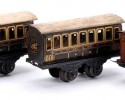
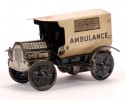
The Early Beginnings :
Although not the earliest of the British tinplate toy companies to anyone who collects tinplate models the name of Wells-Brimtoy is synonymous with quality models, well made and nicely lithographed.
However the story of Wells-Brimtoy is not so straight forward and one needs to look into its “family tree” to see how exactly it came about. Wells-Brimtoy was in fact the end result of the amalgamation of two or perhapse that should be three seperate London toy manufacturers – Brimtoy Ltd. (who had their roots firmly established in the earlier British Metal & Toy Manufacturers) and its take over by A.W.J. Wells in 1932.
So in order to look at the formation of Wells-Brimtoy we need to go back to the very beginning and start with the background and history of the British Metal & Toy Manufacturers (abbreviated in future to BMTM)
British Metal & Toy Manufacturers : 1914 – 1921
BMTM was registered in Sept.1914 with a substantial capital at the time of £35,000, making it one of the six largest such firms in Britain. In 1915 its offices were at given at Audrey House, Ely Place, Holburn, London E.C. whilst its works were listed at Clissold Park, Hackney, but in 1919 the company was at 153 Green Lanes, Stoke Newington, N16.
The outbreak of the First World War did much to shape the future of the British toy industry and set the pattern for the rest of the C20th. Anti-German feeling was understandably high following the formal declaration of hostilities and several toy companies at the time urged the general public to buy British toys made by British labour with British materials !
German toy imports, which stood at c£149,000 in 1914 were down to just c£1,000 by 1915 which left a major gap in the British market, a gap which was initially filled by the USA but more significantly by Japan. However both were thwarted by the severe restrictions on toy and game imports imposed in March 1916 by the Board of Trade.
With this legislation in place, together with other incentives and initiatives from the Board of Trade, the way was now clear for British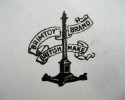 companies to fill this void. One such company was the British Metal & Toy Manufacturers, which incorporated the letters from within its name to form the trademark – ‘BRIMTOY BRAND’, with the words ‘BRITISH MADE’ and a pictoral representation of Nelsons Column all within a roundal. Nothing could be more patriotic in those times !
companies to fill this void. One such company was the British Metal & Toy Manufacturers, which incorporated the letters from within its name to form the trademark – ‘BRIMTOY BRAND’, with the words ‘BRITISH MADE’ and a pictoral representation of Nelsons Column all within a roundal. Nothing could be more patriotic in those times !
Even so it was not that straight forward for although it had work for 100 toolmakers due to the higher wages offered in the expanding war industries it could only recruit a mere 12. The prospects of quick profits were not all they seemed and the overall picture was summed up by the BMTM – M.D. Sidney Stowe in 1917 when he commented that his company was having to face up to four major problems. Firstly; a shortage of working capital, caused in part by escalating labour costs. Secondly; a massive rise in the costs of raw materials (when available). Thidly; a serious shortage of skilled workers and finally, a total lack of exports.
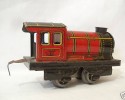 These were however difficulties not just faced by BMTM, but by the toy industry as a whole, and unable to overcome several or all of these problems it was no surprise that many of the smaller companies at this time disappeared altogether.
These were however difficulties not just faced by BMTM, but by the toy industry as a whole, and unable to overcome several or all of these problems it was no surprise that many of the smaller companies at this time disappeared altogether.
When the guns fell silent in Nov.1918 the economic prospects for the British toy industry appeared relatively good. Within just three weeks of the Armistice ‘The Times’ reported that even shopkeepers were astonished by the amount of money that was changing hands for toys, due in the main to high demand and high raw material costs.
Everyon anticipated a rosy future with the world markets now opening up to 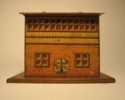 British manufacturers, the demand from which would dwarf the home markets which had kept the industry going. The boom which followed was short lived and lasted just two years ! Consumer expenditure rose by 21% between 1918 – 19 and the removal of wartime controls in the spring of 1919 gave it further impetus. But productive capacity could not keep pace with demand and as a result prices rose faster than output, which in turn pushed up wages and thus costs. By the middle of 1921 Britain was in the grip of severe depression with c2,400,000 workers unemployed. This inevitably took its toll on the toy industry with hundreds of companies closing their doors. One such company, despite having a turnover of £75,000 in 1919 and 1920, was the British Metal & Toy Manufacturers which was liquidated in 1921.
British manufacturers, the demand from which would dwarf the home markets which had kept the industry going. The boom which followed was short lived and lasted just two years ! Consumer expenditure rose by 21% between 1918 – 19 and the removal of wartime controls in the spring of 1919 gave it further impetus. But productive capacity could not keep pace with demand and as a result prices rose faster than output, which in turn pushed up wages and thus costs. By the middle of 1921 Britain was in the grip of severe depression with c2,400,000 workers unemployed. This inevitably took its toll on the toy industry with hundreds of companies closing their doors. One such company, despite having a turnover of £75,000 in 1919 and 1920, was the British Metal & Toy Manufacturers which was liquidated in 1921.
Brimtoy Ltd. : 1923 – 1932
With the demise of many toy manufacturers including the BMTM in 1921 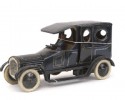 there were, it has to be said, many others who opened up to take advantage of the upturn in trade which took place after 1923. One such company which was founded in 1923 was Brimtoy Ltd., who included amongst its directors many from the now defunct BMTM and which continued, as before, in the production of tinplate toys. Their address was given as 133 Highbury Quadrant, Islington, London N5.
there were, it has to be said, many others who opened up to take advantage of the upturn in trade which took place after 1923. One such company which was founded in 1923 was Brimtoy Ltd., who included amongst its directors many from the now defunct BMTM and which continued, as before, in the production of tinplate toys. Their address was given as 133 Highbury Quadrant, Islington, London N5.
Brimtoy was a listed exhibitor (Stand C39) at the British Industries Fair held at the White City, London in 1929 where they were given as : A manufacturer of metal toys both mechanical and non-mechanical, advertising & constructional toys, money boxes and strong toys.
Brimtoy was acquired by A. Wells in 1932, at the time it employed some 300 workers.
A.W.J. Wells : 1919 – 1932
Wells was a metal toy company founded by Alfred Wells, a toolmaker, in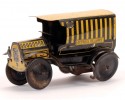 1919 launched with a capital of just £50. Because of his background Wells was able to make his own tooling and initially also did his own selling, so successfull was he that his company was destined to become a major force in the interwar years.
1919 launched with a capital of just £50. Because of his background Wells was able to make his own tooling and initially also did his own selling, so successfull was he that his company was destined to become a major force in the interwar years.
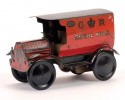 Wells operated from the ‘Progress Works’, 90 Somers Road, Walthamstow, in North London and their well known Wells ‘O’ London trademark first made is appearance in 1924.
Wells operated from the ‘Progress Works’, 90 Somers Road, Walthamstow, in North London and their well known Wells ‘O’ London trademark first made is appearance in 1924.
Like Brimtoy, Wells also exhibited at the British Industries Fair in 1929 (stand D23), where they were listed as : A manufacturer of mechanical and non-mechanical tinplate toys.
Wells, at this time emloying some 200 workers, went on to acquire Brimtoy Ltd. in 1932 and thus form the new company of Wells-Brimtoy which will be dealt with in ‘Part 2’.
